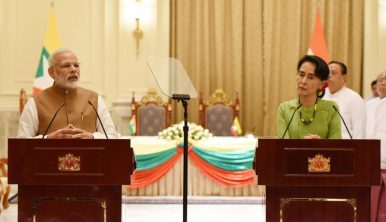By Prashanth Parameswaran
 On January 3, the Indian Cabinet approved an agreement between India and Myanmar on land border crossing. Though specifics remain unclear, particularly amid challenges faced by both countries including confronting the Rohingya crisis and aligning on various aspects of cross-border regulation, the move is nonetheless notable. India has been engaging the Southeast Asian region through its “Act East” Policy under Prime Minister Narendra Modi – billed as a more active approach relative to the Look East Policy of the 1990s – and Myanmar is the only Southeast Asian country with which India shares a land border. Though there are several important aspects of the India-Myanmar relationship, one of these is the management of this shared 1,643 kilometer border.
On January 3, the Indian Cabinet approved an agreement between India and Myanmar on land border crossing. Though specifics remain unclear, particularly amid challenges faced by both countries including confronting the Rohingya crisis and aligning on various aspects of cross-border regulation, the move is nonetheless notable. India has been engaging the Southeast Asian region through its “Act East” Policy under Prime Minister Narendra Modi – billed as a more active approach relative to the Look East Policy of the 1990s – and Myanmar is the only Southeast Asian country with which India shares a land border. Though there are several important aspects of the India-Myanmar relationship, one of these is the management of this shared 1,643 kilometer border.
Border management between the two sides has been framed around a range of concerns, from the security threat India perceives from insurgent groups in India’s northeast to the regulation of local economic activity between people on both sides of the border, which is of interest from both sides to unlock the opportunities of cross-border connectivity while managing the challenges it poses.
Of late, however, the focus has also been on the Rohingya crisis, with local Indian politicians in particular playing up fears about illegal immigration and the resulting security consequences. Modi himself was silent on the Rohingya issue during his first bilateral visit to Myanmar last September, in line with India’s long-held tendency to put strategic concerns above rights considerations.
India has also begun to take some steps along both the India-Myanmar and India-Bangladesh borders to manage any potential infiltration, including the deployment of more personnel and technology and the mulling of new methods of regulation.
Despite these challenges, India and Myanmar have also slowly continued to move forward on specific elements of border management, be it movement toward the opening of new border points or alignment on visa regulations. This is a far more complex process than is often appreciated, particularly given the volume of traffic, the presence of dozens of (formal and informal) border crossings, and the fact that Indian tribal communities along the border have free movement.
On January 3, the Indian Cabinet approved the agreement between the two sides on land border crossing. The Indian government said that the agreement was an “enabling arrangement for the movement of people” across the India-Myanmar border, designed both to facilitate regulation and harmonization of the movement of people and to provide connectivity and enhance interaction between those from India’s northeastern states and the people of Myanmar. However, no specifics were provided about the actual terms of the agreement.
Though the Indian government did not tie the announcement of the pact directly to broader ASEAN-India ties and the Act East Policy, the development does come amid a busy few weeks for ASEAN-India relations, which New Delhi had been signaling since the end of last year. All ten ASEAN countries have been invited to India’s Republic Day celebrations on January 26, and Indian External Affairs Minister Sushma Swaraj is currently on a tour of Southeast Asian states.
No comments:
Post a Comment